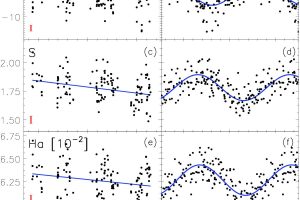A new super-Earth discovered thanks to Harps-N. The study “HADES RV Programme with HARPS-N at TNG. GJ 3942 b behind dominant activity signals” of M. Perger published by A&A

The analysis of radial velocity is one of the two main methods used to detect exoplanets. This method consists in measuring the Doppler effect on stellar spectra deriving the velocity component along the line of sight (the radial velocity). If the star has a planet, they both orbit around the common center of mass, producing periodic oscillations of the osberved radial velocity.
Despite being an easy concept, the identification of exoplanets using the radial velocity method is far to be simple. Periodic variability in stellar spectra, in fact, can be produced also by stellar activity, stellar oscillations, granulation, etc… and it is very difficult to disentangle signals due to planets from those due to such phenomena.
The study: “HADES RV Programme with HARPS-N at TNG. GJ 3942 b behind dominant activity signals” of M. Perger (Institut de Ciéncies de l’Espai), recently published by Astronomy & Astrophysics with the collaboration of the astronomers of the Astronomical Observatory of Palermo L. Affer, G. Micela e J. Maldonado, presents the analysis of 145 spectroscopic observations of the M star GJ 3942, gathered over more than three years with the instrument HARPS-N mounted on the Telescopio Nazionale Galileo, with the aim of finding periodic variability in its radial velocity and discern between signals due to stellar activity and that due to the presence of exoplanets.
The results show that both phenomena can occur simultaneously. The dominant periodic signals in the radial velocity variability of GJ 3942 is modeled considering stellar activity and rotation. The second strongest signal, with a period of 6.91 days, is instead due to the presence of a super-Earth with a mass of about 7 solar masses, an equilibrium temperature of 590K, and with an orbit major axis of about 0.06 AU. A third significant signal is also detected, but not clearly associated neither with stellar activity or the presence of a second planet.
The figure (link) shows the observed data sets (radial velocity, chromospheric activity S index, and Halpha line intensity) on the left panels, while on the right panels the data sets folded according to the main observed periodic variability.
